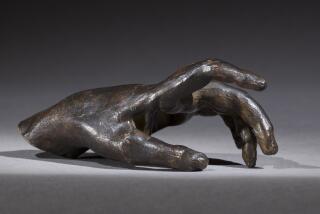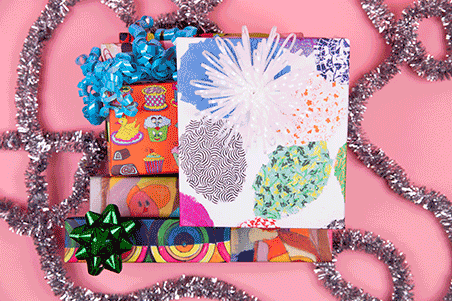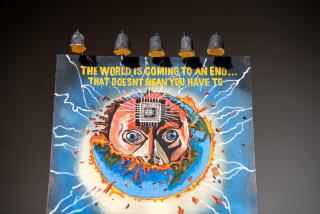A Master of the Collapsed Pencil
A poster that Los Angeles graphic artist April Greiman created for a museum exhibit called “Graphic Design in America” says it best.
The composite image of an American flag reads from left to right. The image begins as a steel engraving, blends into a reproduction of offset printing, then looks as if it came from a video screen, finally transforming into a pixeled, computer-generated image. Greiman’s point: Of all the art forms, graphic design is most thoroughly influenced by new technology.
“Graphic design equals technology,” says Greiman. “It has always been a product of the technology of the times.”
Working in a profession where purists still sometimes denigrate computer technology, Greiman, more than nearly any artist in her field, has shown how the tools can be brought into the service of artistic vision in graphic design, even as they influence the art form. In the process, her style of manipulating images, text and color have won her national and international recognition.
Characteristically curious, Greiman bought her first Apple Macintosh more than a decade ago. “I thought I was buying another fun little tool, but instead I was buying a revolutionary process,” she says.
Computer graphics technology became an inseparable part of her work process, and she eventually moved to the forefront of the technology; software companies even started coming to her to test their new graphics packages.
Now Greiman teaches courses in graphic and computer design at the Southern California Institute of Architecture in West Los Angeles.
“A lot of established designers say, ‘I’ll never give up my pencil,’ ” she says. “But I have to tell them that [computer technology] is just another kind of pencil--the difference is that it collapses a lot of different pencils into one.”
Greiman has no fear of being labeled a geek: Her training as a graphic artist is as classically grounded as they come. After receiving a bachelor of fine arts in graphics at the Kansas City Art Institute, she did graduate studies at the Basel School in Switzerland, a world-renowned bastion of the graphic arts. The native New Yorker came to Los Angeles in 1976 for a three-month project and stayed for the weather. For years, she has worked out of a computer-filled loft at the Brewery complex in Lincoln Heights, but she conducts much of her business electronically via the Internet.
“My clients are all over the world, but all like-minded people are unified by this medium,” she said.
She never knows what kind of work will come next: She’s been hired by museums (L.A. County, L.A. Museum of Contemporary Art, New York’s Museum of Modern Art), by architects and by corporations. Her projects are as varied as her client list. She has designed 4-foot posters and 40-foot billboards, letterheads and organizational graphic “identities,” as well as giant printed coverings for building facades.
She’s currently designing the graphics for the dishware at a restaurant in Taipei, and she’s created television spots, World Wide Web sites and multimedia CD-ROM designs.
One of Greiman’s tiniest designs may actually have been her most prestigious: The U.S. Postal Service selected her design for a 1995 stamp commemorating the 75th anniversary of the 19th Amendment to the Constitution, which gave American women the right to vote. The stamp, a composite image of a 1919 suffragette march, a 1976 ERA march and the U.S. Capitol, is only the second stamp in U.S. history to have been designed by a woman.
Paul Karon can be e-mailed at: pkaron@netcom.com
(BEGIN TEXT OF INFOBOX / INFOGRAPHIC)
Bio: April Greiman
Age: 48
Profession: Graphic designer
Software: Adobe Pagemaker, Photoshop
Computer: Apple Macintosh 9500
More to Read
The biggest entertainment stories
Get our big stories about Hollywood, film, television, music, arts, culture and more right in your inbox as soon as they publish.
You may occasionally receive promotional content from the Los Angeles Times.










